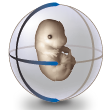Image Processing - Method 4
Protocol
This method for registering images of thin epoxy resin sections is a three- stage process comprising primary pair-wise registration, shape optimisation and finally quality check and shape-controlled re-alignment. In all of these stages individual images are aligned using rigid-body transformation i.e. no shear or non-linear warping of an individual 2D image.
Primary Registration
The section images were registered in a pair-wise sweep through the stack, i.e. the second image aligned to the first, then the third image to the second and so on. For each alignment the global mutual information was maximised by adjusting the rigid body transform (translation and rotation only). This was implemented using the Mattes Mutual information [Mattes et al, 2003] as implemented by the ITK toolkit [www.itk.org, Ibanez et al, 2005]. This primary registration was subject to an automatic quality check by calculating the sum of squared grey-value differences for each adjacent image pair. Potential anomalies will result in a sudden jump in this measure and can then be checked and if needed re-aligned after adjusting search space parameters. This technique provides a fully automatic registration but can suffer from a gradual drift in alignment and correct reconstruction of the original geometry is not guaranteed. This is corrected in the shape optimisation phase.
Shape Optimisation
In this phase a 3D optical projection tomography (OPT) image of the embryo before physical sectioning is used in conjunction with biological knowledge to adjust the automatic alignment so that the resulting geometry is more faithful to the original embryo. For this application biological knowledge is used to define the mid-sagittal plane and this was coupled with the OPT image to ensure correct symmetry. The process was applied as three steps:- 1. Nuclei of selected cells in the base of the neural groove were used
as markers of the rostrocaudal axial midline of the embryo, and their
coordinates obtained in the original section plane. A spline was
defined by these coordinates and the midsagittal plane was defined as
the best fitting plane through this spline using least squares
distance of the spline from the plane. Each image position was then
adjusted so that the intersection point of each image plane with the
spline were brought to the mid-sagittal plane using only translation
and rotation;
- 2. A shear correction was imposed at a small angle to the midline, with
the correction plane cutting the midline at the level of the junction
of neural groove, foregut and oral plate, to rectify differences with
the OPT dimensions viewed dorsally;
- 3. A second shear correction was made orthogonal to the first to adjust
discrepancies in the lateral view.
All these adjustment were made using the Woolz image processing tools.
Quality Check and Shape Controlled Re-Alignment
Local misalignments, detected either on the surface rendering of the reconstruction or as breaks in cellular continuity in the yz orientation, were adjusted by reapplying the mutual-information maximisation within a neighbourhood of the error (typically ±10 planes). To ensure that the global shape remained correct, the first and last section image of the neighbourhood are kept fixed. This realignment used a combination of the ITK mutual-information alignment option coupled with Woolz tools to interpolate the rigid-body transforms.
Ibanez L., Schroeder W., Ng L. and Cates J., The ITK Software Guide Second Edition Updated for ITK version 2.4, 2005 (Kitware Inc) ISBN: 1-930934-15-7.
D. Mattes, D. R. Haynor, H. Vesselle, T. K. Lewellen, and W. Eubank. PET-CT image registration in the chest using free-form deformations, 2003, IEEE Trans. on Medical Imaging,22(1):120-128.




